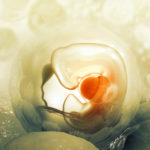In March, I helped draft and co-signed the “Statement from Pro-Life Catholic Scholars on the Moral Acceptability of Receiving COVID-19 Vaccines,” published here at Public Discourse. Today, I respond to a recent article critical of our statement. I wish to make clear that I speak for myself only; other signatories do not necessarily endorse what I say here and may well disagree with some of what I say.
Our purpose was to ask: “Is one in any way endorsing or contributing to the practice of abortion, or is one in any way showing disrespect for the remains of an unborn human being” in using vaccines that have relied in one or another way on cell lines that originated from aborted human remains? And we concluded that the answer is no in both cases. The abortion from which the HEK293 cell line was derived, for example, took place over fifty years ago. It is a distinct, non-repeating event, to which the current use of HEK cells does not contribute. Further, cells derived from the HEK line are not in any way parts of that aborted child. Around the globe, new cells are continually being derived from the HEK line; no such cell once was part of the aborted child. So, we concluded, use of such cells does not show disrespect for the remains of an unborn human being.
Thus, we concluded, use of vaccines derived from such cell lines is morally permissible, with no substantive moral difference to be found between vaccines according to the role played by HEK cells in their development.
Michael Pakaluk has replied in a recent essay on the Crisis website. He initially takes us to task for an analogy we draw between receiving good from these cell lines and receiving good from the products of slavery:
Start your day with Public Discourse
Sign up and get our daily essays sent straight to your inbox.For [the co-signers of the Statement], it’s as insanely deluded to wish to avoid vaccines developed using cell lines derived from an abortion as it would be to avoid ancient Roman roads today for fear of cooperating with the Roman system of slavery which built them millennia ago. This is their own analogy.
But this is not our analogy. What we said was:
Its use does not show disrespect for human remains, any more than the contemporary use of products, such as roads or train lines, that were constructed by unjustly enslaved human beings, or use of land unjustly taken, shows disrespect for those victims in the distant past.
The words “or train lines” and “land unjustly taken” indicate that we were not talking of ancient Rome, but of an issue of plausible similarity to cell lines from abortions, that of receiving good from the products of American slavery and the unjust appropriation of Native American land. The difference matters: it is not “insanely deluded” to be concerned with the appropriation of the fruits of our own nation’s injustice, but I believe, for most people, it is permissible and in some cases obligatory to use our nation’s roads, even if grave injustices in the past are part of the story of how they came to be built.
Pakaluk also believes that we “contradict” ourselves in our analysis of how materially close the use of HEK cells is to the aborted child:
If the cells they think are acceptable are, as they say, “immortalized,” that is, these cells keep on living, then these cells now are the same as the cells that were taken from the aborted child. One could have pointed to the cells immediately after they were cultured in 1972 and have said, truthfully, “these cells of the aborted girl are immortalized,” that is, someone considering them in 2021 will be considering the same cells.
However, we never refer to “immortalized cells.” Rather, we refer consistently to immortalized cell lines. Such cell lines contain no immortal cells, nor do they purchase their immortality by maintaining some set of cells permanently in existence. Rather, such cell lines perpetually renew themselves; unlike ordinary cells, which can give rise to only a limited set of successor cells through cell division before senescence occurs, immortal cell lines contain cells that have been modified so that their successors continue to reproduce by cell division “forever.”
The modification of fetal tissue to produce the immortal line involved significant alteration of the original fetal genome. HEK293 cells thus contain roughly twice the normal amount of human DNA, in addition to multiple copies of a viral gene introduced by the experimenters. Moreover, HEK293 cells are genetically unstable, and have spontaneously “drifted” over the half century since they were produced, resulting in a diverse set of related cell lines with distinct genetic characteristics.
What this means is that no cells today that are considered HEK293 cells, nor any cells derived from the HEK line, are “the same cells” as those “cells of the aborted girl [that were] immortalized.” Indeed, any current HEK cells are vastly many generations removed from the original line created in the 1970s, and often genetically distinct from the original as well.
This makes clear, perhaps, just how far removed from the original evil act, and the child’s unjustly treated remains, current HEK cells are, to say nothing of products made or tested with such cells. Unlike the wood of the Cross, to which Pakaluk compares the use of HEK cells in order to illustrate the moral importance of proximity to good or evil, there is no numerical identity, and no genuine physical proximity, between HEK cells in 2021 and the cells of the child whose life was unjustly taken in the 1970s. So the attempt to show that there is a close “materiality of physical connection” of HEK293 cells to the abortion of a child in 1972 does not seem successful.
Pakaluk makes a further argument that relies on claims of cooperation. This argument is unlike some that assert material cooperation with the original abortion. Pakaluk believes, as do I, that this is a blind alley: no act of vaccine production or use today assists in that abortion in 1972.
But that abortion was not the only morally wrong act in the 1970s. There was, in addition, the wrongdoing of Alex van der Eb, the creator of the HEK cell line. On both my own view and Pakaluk’s, no agent had moral authority to donate the murdered child’s remains to a lab for scientific research. So van der Eb ought to have done the responsible thing for anyone in receipt of the remains of an unjustly killed human being, and, as Pakaluk says, pursued “its reverent burial.” He did not. I believe that he was wrong in so acting and in generating the HEK293 cell line.
Pakaluk then writes:
But surely, then, Van Ep’s [sic] production of the cell line, and the eventual marketing and sale of the cells (see HEK293.com [http://www.hek293.com/]), is an incomplete action in the past, the first half of a reciprocal exchange, which is completed now in the present by anyone who purchases and uses those cells, and which amounts to formal cooperation in Van Ep’s depraved purposes and acts.
That is to say, Pakaluk contends that there is no cooperation of any sort with the original abortion, but there is formal cooperation with van der Eb’s moral wrongdoing in the purchase and use of HEK cells. This would be a very strong conclusion, for formal cooperation with evil is always impermissible. If this argument is sound, then, for example, the various Catholic universities that make use of HEK cell lines in their research ought to desist immediately. Pakaluk seems confident of this judgment, but the following reasons seem to me to tell against it.
First, as noted, the cells that are currently purchased are neither the cells that van der Eb (presumably) illicitly accepted from an abortionist, nor are they even the same cells that he effectively created through intervention upon those original cells. Recently purchased cells are removed by multiple generations, multiple technological interventions, and in most cases genetic modifications or drift from the cell line initially created over fifty years ago. Someone who buys a 2021 Ford automobile is not engaged in the second half of a reciprocal exchange with Henry Ford.
Second, those who purchase HEK293 cell lines do not purchase them from van der Eb or from any representative of van der Eb. A Google search suggests that there are multiple vendors from which these cells may be purchased, whose connection with van der Eb is far from clear. Someone who buys a used Ford automobile, modified by intervening owners, is not engaged in the second half of an exchange with the Ford dealership that originally sold the car. (Please note the limited though, I believe, useful purpose of this analogy: I am not treating the inherent dignity of a human being as on a par with the merely instrumental and contingent value of an automobile.)
These are reasons to think that the purchase of HEK293 cells, today, does not complete an action begun by van der Eb in the 1970s. The reasons to think that the use of those cells also does not constitute any form of cooperation with van der Eb are surely even stronger. Once the cell culture is purchased by some lab, it is alienated from whoever sold it (not, in any contemporary case, van der Eb), and the connection with that seller is severed. Someone who drives a Ford automobile around after purchasing it does not, in driving, cooperate in any way with Henry Ford, the Ford Motor Company, or the salesman who drew up the papers on the lot.
Nor, to look at what seems to me a plausible, and certainly not insane, analogy, are those who purchase houses or land in Georgia, Tennessee, Alabama, North Carolina, or Florida engaged in cooperation with Andrew Jackson’s unjust removal of Native Americans from their land. Jackson and his agents should not be considered to have engaged in an incomplete action in the past, the first half of a reciprocal exchange, which is completed now in the present by anyone who purchases and uses this land, and whose purchase and use amount to formal cooperation in Jackson’s depraved purposes and acts.
Neither Pakaluk’s criticisms of our Statement nor his positive arguments seem to me to hit their mark. It does not seem to me correct to say, in particular, that the purchase and use of HEK and similar cell lines is intrinsically impermissible.
So neither Pakaluk’s criticisms of our Statement nor his positive arguments seem to me to hit their mark. It does not seem to me correct to say, in particular, that the purchase and use of HEK and similar cell lines is intrinsically impermissible.
But if such purchase and use are not intrinsically impermissible, then some and perhaps many people may reasonably be moved by the very strong reasons that exist to take the vaccine to do so. As the Congregation for the Doctrine of the Faith noted in its Statement of December 2020, “In the absence of other means to stop or even prevent the epidemic, the common good may recommend vaccination, especially to protect the weakest and most exposed.” Some people might, in fact, be personally obligated to take the vaccine, as Pope Francis has suggested.
Yet if, as we have clearly asserted, others may choose not to take the vaccine in order to give Christian moral witness to the value of unborn human life and the injustice of abortion, then there must also be some reasons against using the vaccine, and this too has been suggested by various bishops and theologians. Such reasons might include the concern about scandal, or confusion. Yet such reasons also seem to include considerations similar to those raised by Pakaluk and others: the very fact that so many of the material resources of Western culture—not just medicinal, but culinary and cosmetic as well—derive from an unjust killing of an unborn child is a stain on all our attempts to live upright lives.
A recent essay in Public Discourse affirmed both sides of the controversy: that it is permissible and for some people in some circumstances obligatory to take vaccines derived from cell lines of illicit origin; and that the connection of these vaccines (and cosmetics, and processed foods) to abortion points to “the depths of our entanglement in this late-modern culture of death.” That is an important point that we did not focus on, and I am grateful to the author for raising it, as I am to Pakaluk, despite our disagreements on certain points, for his ongoing witness to the value of human life.














